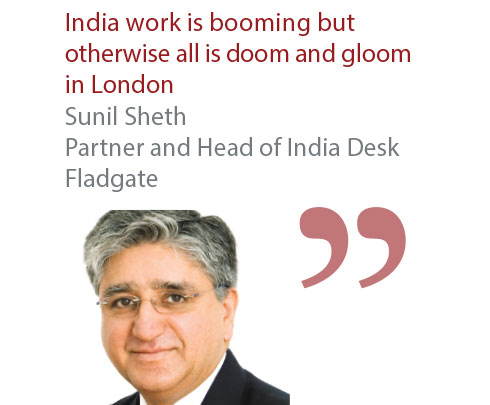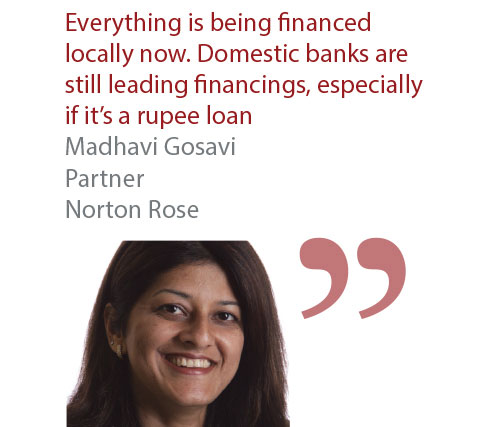As the UK economy struggles to regain its former momentum, London-based lawyers are turning to India to spice up their practices
So begins Andrew Lloyd Webber’s Bombay Dreams, a popular West End musical which enamoured British theatregoers until 2004 with a tale of two lovers set against a Bollywood backdrop. Five years later, Indian film director Vipul Amrutlal Shah captured Indian audiences with his film London Dreams, a story of two childhood friends who leave a small village in India and become rock stars in Wembley. The protagonists sing in Hindi: “Spread your wings, lose your fear … live your London dreams …”
The enduring affection of India and the UK for each other extend far beyond the big screen. In 2007 then London mayor Ken Livingstone opened a three-month summer festival called India Now, a series of events showcasing Indian art, culture and music around the city to mark the special relationship that London has with India and its people. The love affair continued last year as the London Book Fair commemorated the diversity of contemporary Indian writing.
The relationship hardly flows in one direction. Indian cricket fans flock to England for test matches; many Indians have holiday homes and spend their summers in the country; some of India’s most senior advocates have been educated at UK institutions and many affluent Indians send their children to school in England.
“There’s a strong London-India circuit here,” says Hardeep Nahal, a litigation partner at Herbert Smith. “Many Indians have homes here, they come over to watch Wimbledon and cricket tournaments, they have kids here in schools, so you can do a lot of relationship nurturing here, much more than you can in Hong Kong, New York or Singapore.”
Efforts to promote trade and investment between the two countries are equally evident. The UK India Business Council, which is supported by the UK and Indian governments, strives to strengthen economic cooperation and synergies within the two common-law jurisdictions.
It is this cultural affinity, comfort and familiarity that are highlighted by lawyers who rationalize the deep connections that underpin the natural partnership between the two countries. “There’s still a huge affection in India for the UK,” says Martin Harman, a partner at Pinsent Masons in London. “We share the same language, the same systems, we have a familiar bureaucracy and legal processes. It’s a natural partnership of like minds … Indians understand how we work.”
But what foundation lies beneath the historical, literary, cultural and economic threads that tie India and the UK together? Is this partnership simply a vague nostalgic memory of a shared history gone by?
Is London Bridge falling down?
Some suggest that collaborations between the two countries, at least on the business front, are limited. “There is a reduction of commitment and focus from UK mid-market firms on India,” explains Sunil Kakkad, partner and head of the India practice at Lawrence Graham. Citing difficulties in predicting market trends in India as one of the key reasons for this decision, Kakkad says: “Funds are redirected elsewhere where fruition is more guaranteed and there is a healthy and profitable stream of work.”
This reluctance of many smaller UK companies to explore the Indian market threatens to keep Britain’s economy stagnant. “Getting small and mid-sized UK companies to get on a plane and risk Delhi belly is so difficult,” laments Toby Greenbury, a consultant at Mishcon de Reya in London. “We need to educate UK businesses on opportunities in India.”
The economic collapse pulled employment rates down drastically in the UK, forcing 5,000 lawyers out of their jobs last year. Experts predict this year will be equally grim with the slashing of another 5,000 legal jobs. “India work is booming,” says Sunil Sheth, a partner and head of the India desk at Fladgate, “but otherwise all is doom and gloom in London. Firms with overseas practices have survived. India’s M&A and capital markets were flat last year, but, since November 2009, things have picked up.”
The downturn led many UK law firms to re-examine their India-focused practices. While some firms cut down on discretionary spending, others have begun to build their India desks in an effort to find alternatives to an exhausted, inactive and capital-conservative client base in the West. To many London law firms, India represents a goldmine with its flourishing economy, burgeoning middle-class consumer spending and cash-rich corporates bullish about global expansion. “Everyone is trying to get on the bandwagon,” says David Dannreuther, a partner at Withers who recently advised the State Bank of India (SBI), Bank of Baroda and Bank of India on the £360 million (US$553 million) guarantee facilities for the European Investment Bank’s loan to Jaguar Land Rover.
Even firms without a strong track record in India are vying for a position on deals going into and emerging from the subcontinent. “Now more than 50 firms want a piece of the India pie in the mid-cap sector,” says Greenbury. “There’s just not enough work in India for 50 big international law firms.”
India ambitions
The legal market in London focusing on India is a cosmopolitan concoction of English, American, European, Canadian, Australian and also Indian practices. For some of these firms, India-related work is like low-hanging fruit; easily plucked, providing they have the skill set and have forged solid relationships with clients and Indian law firms alike. For others, India is less an opportunistic project and more an important part of a wider strategy to strengthen existing networks in emerging markets.
Matters typically handled from London for India-focused clients include corporate M&A transactions, capital markets, restructuring, financing, competition, taxation, telecoms, media and technology, outsourcing, employment, energy, infrastructure, dispute resolution and foreign direct investment. Ashurst, Cleary Gottlieb Steen & Hamilton, Dorsey & Whitney, Latham & Watkins, Linklaters and Shearman & Sterling are among those which have sealed their reputations in capital markets, having completed equity offerings valued between US$500 million and US$1.6 billion over the past year.
On the project finance, energy and infrastructure front, well known players include Allen & Overy, Clifford Chance, Eversheds, Freshfields Bruckhaus Deringer, Herbert Smith, Milbank Tweed Hadley & McCloy, Norton Rose and Pinsent Masons. Capitalizing on their M&A clout are firms such as Davis Polk & Wardwell, Kelley Drye & Warren, Mayer Brown and Skadden Arps Slate Meagher & Flom. A significant amount of dispute resolution is also handled by UK firms such as Denton Wilde Sapte and Slaughter and May for Indian clients.
Other firms are leveraging their strengths in niche areas. Peter Brudenall, a partner at Hunton & Williams where outsourcing is a core focus, says the firm has a coordinated India effort, but not a practice group. “We represent clients such as Wipro, WNS Global Services and Tata Consultancy Services on employment, tax, real estate and disputes work that originates from these outsourcing companies.”
Similarly, Olswang focuses on specialties such as pharmaceuticals, media, leisure, telecoms, power and infrastructure. “We work on fundraising in media, sport and entertainment in India,” says David Roberts, a partner at the firm. “It’s a vibrant practice. We have inherited secondary business from the Indian Premier League.” The firm recently advised SIS Live on a contract to produce and broadcast the Commonwealth Games in Delhi in October.
Warren Cabral, a partner at Appleby in London, explains that his firm has looked at London not only as a market in and of itself for UK and European work, but also as a through route to many of the major economies around the world, in particular India and the other “BRIC” countries, Brazil, Russia and China. While London is an ideal legal gateway to investigate corporate opportunities and investments into India, law firms are increasingly seeing activity in the reverse direction – servicing the ambitions of Indian corporates keen to enlarge their global footprint in British, European and American markets. Indian firms have a part to play.
Based in London, ALMT Legal, FoxMandal Little and Singhania & Co all advise clients on Indian law. ALMT partner Shalini Agarwal stresses the importance of her firm’s immigration and employment practice for corporates entering India and those leaving India to enter London, while Ajit Mishra, a partner at FoxMandal Little, emphasizes that “inbound work for India is our prime target”. Singhania & Co also offers “value addition – matchmaking Indian companies buying US and European entities,” when advising on inbound transactions to India, says partner Vijay Goel.
Despite the rising importance of legal hubs such as Singapore and Hong Kong, most lawyers believe London’s pre-eminence as a mature financial market and its geographic proximity from a global perspective will ensure its prominence on India deals. “I believe the role of London firms will become more pivotal as transactions become more global and inter-linked,” says Manoj Ladwa, a partner and chief executive at MLS Chase. “We see [fewer] transactions that are purely India-UK. There is invariably an offshore or multi-jurisdictional angle.”
The financial centre of gravity
Widely lauded as the world’s financial capital, London is perceived by Indian investors as a key market in which to generate funding. “We’ve had phenomenal success in India over the last year with our involvement in the Rural Electrification Corporation IPO and Oil India IPO,” says Richard Gubbins, partner and head of the India group at Ashurst. After a lacklustre year, capital markets activity has begun to bubble again with KSK Power Ventur’s recent move from the alternative investment market (AIM) to the main market of the London Stock Exchange (LSE) and Essar’s plan for a US$2 billion listing on the LSE.
The maturity of the market is highly attractive to Indian companies, many of which have chosen to list on the AIM. “Indian and BRIC companies are doing business with London,” says Jonathan Morris, a corporate finance partner at Berwin Leighton Paisner. “Especially if you’re looking to raise money on the stocks, London will be important.”
AIM has been successful in drawing a number of Indian corporates such as Great Eastern Energy Corporation and Noida Toll Bridge Co. In fact, 24 Indian companies listed on the AIM between 2005 and 2008, adding some sparkle to what was otherwise a very depressed market. With phenomenal growth in sectors such as natural resources, energy, manufacturing, hospitality and infrastructure, more Indian companies are choosing London over India when exploring avenues to raise capital. Jonathan Martin, a partner at the London office of US firm King & Spalding, admits the markets are witnessing an upswing in activity but highlights the regulatory difficulties associated with listing on AIM. “Indian markets are pretty liquid and stocks have performed very well, but largely at the top end. This masks underlying issues … the mid-cap end is tough. You can’t list an Indian company on AIM … Indian companies can’t just raise money on foreign markets because Indian regulations prohibit this. So one structure is using an Indian holding company.”
Pranav Trivedi, a partner at Skadden in London, agrees with this observation. “From an execution perspective, it’s easier to do global depositary receipts and board listings than AIM listings, so I don’t understand why they are so popular,” he says.
The road to recovery
India’s minister of road transport and highways, Kamal Nath, visited London in February this year in a bid to encourage greater participation from UK companies to help the country achieve its urgent infrastructure goals. Nath led a delegation of officials from the National Highways Authority of India and about 15 major Indian infrastructure company CEOs to participate in the “India Infrastructure Forum” jointly organized by the Confederation of Indian Industries, the Commonwealth Business Council and the UK India Business Council.
Nath also chaired a conference organized by the newly formed British India Roads Group (BIRG), urging its members to engage in active partnerships and investments. The BIRG consists of major UK infrastructure companies which are exploring possibilities to invest in such projects in India.
“India is looking at London to persuade people in the UK to provide construction expertise to participate in Indian infrastructure,” says Harman at Pinsent Masons. “India doesn’t have the capacity to solve its infrastructure needs – it requires assistance from the UK. Indians want the UK to be more active in India from business plans, to design, to construction, to legal work and operations.”
According to Stewart Sutcliffe, a partner at Canadian firm Stikeman Elliott in London, Nath has been equally aggressive in Canada, admonishing Canadians for being too narrow and focusing on US investment. “We have some of the top engineering firms looking to enter India to assist with infrastructure projects, nuclear technology companies and of course, very obviously, the oil and gas, mineral and energy companies in the natural resources sector,” he says. In addition, London lawyers are being consulted on financings in other areas of development including energy, power, and oil and gas. To a large extent, financings have been handled domestically by banks in India which remained robust during the economic downturn. From that perspective, the role of London-based law firms has been limited. “The energy, power, oil and gas sectors have been relatively quiet because power projects in India have been quite indigenous,” says Jeremy Sheldon, a partner at Fulbright & Jaworski.
Madhavi Gosavi, an infrastructure and projects partner at Norton Rose, shares a similar view: “We’ve acted for foreign banks in terms of financings in the infrastructure space, but everything is being financed locally now,” she says. “Domestic banks are still leading financings, especially if it’s a rupee loan. Indian banks have limited cap restrictions on how much they can lend, especially the SBI, so they cannot compete with what foreign banks can lend.”
Despite their lending restrictions, Indian banks are gradually becoming more active on international deals. “They’re becoming involved in the financing of UK operations and beyond that, to lend in the London bank market,” explains Jonathan Brayne, a partner and head of the India group at Allen & Overy.
Indian banks have a significant presence in London with names such as Bank of Baroda, ICICI, Punjab National Bank, SBI, Bank of India and IndusInd Bank on the ground. “We’re also acting for Indian banks lending outside India as they internationalize,” says Raj Karia, a partner at Norton Rose. “They’re following their clients out of India to service those deals.”
Conquering new territory
Much like the replica of the Taj Mahal that floated down the River Thames in 2007 during London’s India Now festival, Indian companies are discovering they have the potential to navigate new waters.
“National gas companies in India are very acquisitive,” says Sheldon. “They are serious players. In the early 1990s, people were looking to invest in India. Now the reverse is happening.”
Most lawyers agree that London is a crucial market for Indian companies venturing into foreign markets in the West, be it the UK, Europe or the US. “London is the first port of call for Indians looking at European acquisitions,” says Laurence Levy, a partner at Shearman & Sterling.
From Mishcon de Reya’s perspective, the increasing desire of Indian companies to expand their businesses overseas is a welcome trend. “The planets are in alignment!” Greenbury enthuses. “India is growing now like the US did in the 1920s. I’m interested in bringing Western technology to India – infrastructure, healthcare, radio frequency identification, energy – in every way. India is playing catch-up and that is phenomenally exciting.”
Several experts underscored the movement in the thriving India-Germany corridor, especially in the insurance and automobile sectors. Omleen Ajimal, a partner at Taylor Wessing and leader of the India group in the UK, observes that much of the activity in this respect is concentrated in the south of the country. “Clean technology companies are being developed and there’s also a substantive automotives practice there, particularly Chennai, which is an automotive hub.”
Players such as Religare, a global financial services group and a leading global emerging markets brand, and retailers S Kumar and Fabindia have also been bullish about acquiring key assets and taking their businesses overseas.
Unfortunately, UK companies have had a less voracious appetite for India. Analysts predict the UK market will be flat for the next three or four years if key investments in emerging economies are not made by British businesses, though some are optimistic that these companies will take the plunge into India.
“Big pharmaceutical companies still have to work out what they are doing about India and the generics market,” says Simon Amies, a partner at Covington & Burling. “I think we can expect to see some companies cross the line of darkness to do business with generics companies.”
Franchising brands on the other hand, have been noticeably more aggressive in penetrating the Indian market. “Toy brand Hamleys is going into India, Gourmet Gulf [a UAE-based food and beverage retail company] is already there and restaurant chain California Pizza Kitchen is planning a foray there,” says Christopher Jackson, a partner at Field Fisher Waterhouse.
Baljit Chohan, partner and head of the India desk at Wragge & Co, believes UK companies should think carefully about entry strategies into India for the sake of creating new lines of profit. “Companies here in the UK are operating in relatively mature markets, so they can position their brands differently when penetrating the Indian market,” says Chohan. He uses clothing store River Island as an example to illustrate how a retailer categorized as a teenage mid-market brand can become new and aspirational in India, targeting a different consumer market. “Indian brands don’t enjoy the same kind of advantage or the same kind of value coming into the UK,” says Chohan.
It is worth acknowledging that while India Inc’s development is important to many international firms, from a financial standpoint, many of these deals occur among mid-market entities and hence generate less exciting amounts than many of the headline India cross-border deals suggest. “India is a small corporate market,” says Greenbury. “Indians will buy, but … the general psyche is to buy too small because they’re cautious and many are family owned companies.”
Fighting your corner
Singapore’s determination to promote itself as a global arbitration hub has led observers to question London’s significance as a centre for dispute resolution. The establishment of the Singapore International Arbitration Centre, the city’s cultural similarity to India and the cheaper costs associated with arbitration there are key reasons why London’s role in mediation may be diminishing. “Singapore has become popular and it’s closer if you’re in the Asia-Pacific region,” admits Ray Werbicki, head of the international dispute resolution group at Steptoe & Johnson. “But arbitration in London is quite different,” he says. “Indian lawyers would gravitate to London but businesses would probably prefer Singapore. The London Court of International Arbitration (LCIA) and [director-general] Adrian Winstanley, in particular, are very interested in India.”
Nahal at Herbert Smith believes London is still a major dispute resolution centre because of the frequency with which LCIA is used. He also questions the extent to which Singapore is being used by corporates to invoke arbitral awards. “Because arbitration is private and confidential, it’s difficult to get accurate data and statistics in order to gauge how many Indian companies actually arbitrate in Singapore.”
Sunil Gadhia, a commercial litigator at Stephenson Harwood and chair of the Asian Business Association, is similarly convinced of London’s place as a major arbitration hub, but recognizes that the city could face competition from Singapore in due course. “Historically, most Indian contracts have specified London, but now more are choosing Singapore,” says Gadhia. “However, some corporates will still use London, feeling that the quality of the process of arbitration in London is better.”
Levy at Shearman & Sterling is equally vocal about London’s long-standing reputation for excellence in dispute resolution. “People are conservative about arbitration. You want a place that’s reliable, predictable and robust and these places are sophisticated and well-trodden.”
Challenges, quirks and competition
For Indian firms interested in pursuing their dreams overseas, London law firms offer the depth and breadth of expertise that is necessary for all forms of capital raising, purchasing and dispute resolution. UK firms have been particularly active, establishing India-focused practice groups, hiring Indian qualified lawyers and making frequent trips to India to bolster their client network and relationships with law firms.
In contrast, US firms have been slow to focus on India. Many suggest the colossal domestic economy in the US gives law firms no need to focus elsewhere. As Nahal at Herbert Smith puts it: “The US has generally been slower about India because they’re so profitable and have [a huge domestic economy].” Gautam Bhattacharyya, a partner at Reed Smith, acknowledges the strength of the legal profession within US law firms but highlights their limited focus. “It’s a very lawyered market,” he says, “but without any discourtesy intended, in the US, abroad is Canada and international is the East to the West of the US!”
David Lakhdhir, a partner at Paul Weiss Rifkind Wharton & Garrison in London, confirms this tendency. “India is very exciting,” he says, “I’d always rather be doing business there, but for the moment, it isn’t a large percentage of our turnover.”
The tremendous buzz surrounding India could fool one into thinking that lawyers are picking up multibillion-dollar deals by the dozen. However, for law firms across the board, India-related transactions can be very underwhelming. As Kakkad at Lawrence Graham reveals, “the average size of an M&A transaction from India is disappointingly low by Western standards”.
For many law firms, especially new market entrants wanting a piece of the action in India, money is hardly a top priority. “The classic approach of new entrants and arrivals is to do work for free,” says Tom Siebens, a partner at Milbank in London. “It’s fair enough as a tactic, but it creates expectations among Indian clients that they can achieve low fees repeatedly.”
Gubbins at Ashurst agrees that such a process is unhealthy. “Lots of firms are going in at rock bottom prices and undercutting everyone in the market,” he says. “What happens as a result is that the quality suffers.”
Veterans in the market have adopted a different approach, partnering with an Indian law firm for greater access to the market. “The AZB tie-up gives us a lot of exposure that we otherwise couldn’t get,” says Andrew Carnegie, partner and head of the India group at Clifford Chance. “We’ve had smaller instructions from India and we weren’t getting as much outward investment and capital markets deals, but now we’re seeing more of that.”
Brayne at Allen & Overy says that just because its Indian partner is on the ground doesn’t mean the firm can be complacent about its India strategy. “We’re close to Trilegal but in the end they’re a separate firm,” he says. “Their finances and systems are separate. We don’t have a group of people in India thinking specifically about Allen & Overy and what’s best for us.”
English firm Slaughter and May says it has no intentions of forming a partnership with a single Indian firm because its strategy has been to work in collaboration with local firms. More importantly, says partner Simon Hall, the Indian legal profession is evolving rapidly, so any tie-up is potentially a volatile one. “The commercial practise of law as we recognize it is 20 years old in India,” he says. “You’re seeing the relative demise of older firms and the emergence of others in their modern incarnation. The family structure is eroding and it’s a changing and unpredictable market.”
Roberts at Olswang believes Indian firms are still working towards achieving best practices. “The Indian legal community is still developing … the level of specialization is low,” he says. “We haven’t come across any firm that has got the depth across the spectrum. Indian firms are desperately looking for access to know-how to accelerate their practice management skills.”
At the same time, Indian lawyers have demonstrated their finesse and sophistication on high-value cross-border transactions, which some worry will lead to the erosion of roles for foreign firms. Several experts say deals going into India have become harder because large corporates are more than happy to engage solely Indian counsel. The way in which transactions are structured in India sometimes offers Indian lawyers – even those with meaty advisory roles – little opportunity to exercise their influence.
Cabral at Appleby draws a distinction between US procedures and Indian processes, arguing that legal experts in the US often play a vital role in shaping a deal. “A lot of transactional deals get cooked up in-house in India,” he says. “Indian lawyers sign off and get involved very late in the day during the final stages. Few Indian law firms can influence the deal flow.”
Law firms based in London are increasingly facing competition from their counterparts in Singapore and Hong Kong, where Indian deals are steadily migrating. Divya Sharma, an associate at Bird & Bird, says Asia is a key and complementary hub for the firm’s India practice. “We have seen some banks and also law firms shift some part of their equity and debt capital markets work relating to India to Hong Kong or Singapore,” she says. “However, London continues to play an important part in equity and debt transactions and increasingly in project finance.”
Sheth at Fladgate believes the movement of such institutions to Asia is significant. “Singapore is coming up very fast,” says Sheth. “It is perceived as more liberal than Europe and tax treaties between India and Singapore are very attractive. In terms of private banking, a lot of money has moved from Switzerland to Singapore, especially banks that want to market to India.”
As far as hubs are concerned, Ashok Sancheti, managing partner at Morgan Walker in London, believes India itself will always be the hub for India work. Sancheti, whose firm has lost a number of Indian-qualified lawyers to high living expenses in London, argues that India should not open its doors to foreign firms unless similar arrangements are made for Indian lawyers overseas. “Indian lawyers cannot work and practise here,” says Sancheti. “The attitude among foreign firms is ‘you stay in your ghetto and we want the moon and Mars’.”
Commenting on the recent writ petition against foreign law firms in Chennai, Harman at Pinsent Masons shares his sympathy for firms like Ashurst which, he says, operated in accordance with its regulatory licence in India. “One gets that slightly unwanted feeling. It’s very short-sighted of the Indian legal profession – or at least the few influential Indian lawyers who oppose liberalization. The reciprocation argument is quite thin. We’re very happy to have a phased operation and not rush in all at once.”
Until the issue is resolved, London’s law firms will continue to face intense competition for a piece of the India pie as the country resolves to realize its local and global ambitions. “India is playing catch-up in such a short span of time – 15-20 years,” says Greenbury at Mishcon de Reya. He believes that the excitement of such development brings with it unavoidable hurdles. “India is leapfrogging – one minute it is a fraction behind Western economies, and then suddenly a fraction ahead.”
Hall at Slaughter and May says it is not just Indian corporates that have a bigger vision to fulfil, but law firms as well, which have grand dreams that have yet to be accomplished. “Twenty years down the line, Indian firms might want to be large firms with offices in London, Paris, Brussels, etc. And why shouldn’t they be? I don’t think anyone has really considered that.”



































